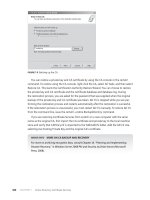Springer applications of intelligent control to engineering systems jun 2009 ISBN 9048130174 pdf
Bạn đang xem bản rút gọn của tài liệu. Xem và tải ngay bản đầy đủ của tài liệu tại đây (17.78 MB, 423 trang )
Applications of Intelligent Control to Engineering Systems
International Series on
INTELLIGENT SYSTEMS, CONTROL, AND AUTOMATION:
SCIENCE AND ENGINEERING
VOLUME 39
Editor
Professor S. G. Tzafestas, National Technical University of Athens, Greece
Editorial Advisory Board
Professor P. Antsaklis, University of Notre Dame, IN, U.S.A.
Professor P. Borne, Ecole Centrale de Lille, France
Professor D. G. Caldwell, University of Salford, U.K.
Professor C. S. Chen, University of Akron, Ohio, U.S.A.
Professor T. Fukuda, Nagoya University, Japan
Professor F. Harashima, University of Tokyo, Japan
Professor S. Monaco, University La Sapienza, Rome, Italy
Professor G. Schmidt, Technical University of Munich, Germany
Professor N. K. Sinha, McMaster University, Hamilton, Ontario, Canada
Professor D. Tabak, George Mason University, Fairfax, Virginia, U.S.A.
Professor K. Valavanis, University of Southern Louisiana, Lafayette, U.S.A.
Professor S. G. Tzafestas, National Technical University of Athens, Greece
For other titles published in this series, go to
www.springer.com/series/6259
Kimon P. Valavanis
Editor
Applications of Intelligent
Control to Engineering Systems
In Honour of Dr. G. J. Vachtsevanos
Editor
Kimon P. Valavanis
Department of Electrical & Computer Engineering
University of Denver
Denver, CO 80208
USA
ISBN 978-90-481-3017-1
e-ISBN 978-90-481-3018-4
Springer Dordrecht Heidelberg London New York
Library of Congress Control Number: 2009929445
© Springer Science + Business Media B.V. 2009
No part of this work may be reproduced, stored in a retrieval system, or transmitted in any form or by any
means, electronic, mechanical, photocopying, microfilming, recording or otherwise, without written permission from the Publisher, with the exception of any material supplied specifically for the purpose of
being entered and executed on a computer system, for exclusive use by the purchaser of the work.
Printed on acid-free paper
Springer is part of Springer Science+Business Media (www.springer.com)
In honour of Dr. George J. Vachtsevanos, our Dr. V.,
from his former students and colleagues
Table of Contents
Preface
vii
List of Contributors
ix
Part I: Diagnostics, Prognostics, Condition-Based Maintenance
1. Selected Prognostic Methods with Application to an Integrated Health
Management System
C.S. Byington and M.J. Roemer
3
2. Advances in Uncertainty Representation and Management for Particle
Filtering Applied to Prognostics
M. Orchard, G. Kacprzynski, K. Goebel, B. Saha and G. Vachtsevanos
23
3. A Novel Blind Deconvolution De-Noising Scheme in Failure Prognosis
37
B. Zhang, T. Khawaja, R. Patrick, G. Vachtsevanos, M. Orchard and A. Saxena
4. Particle Filter Based Anomaly Detection for Aircraft Actuator Systems
D. Brown, G. Georgoulas, H. Bae, G. Vachtsevanos, R. Chen, Y.H. Ho,
G. Tannenbaum and J.B. Schroeder
65
Part II: Unmanned Aerial Systems
5. Design of a Hardware and Software Architecture for Unmanned Systems:
A Modular Approach
R. Garcia, L. Barnes and K.P. Valavanis
6. Designing a Real-Time Vision System for Small Unmanned Rotorcraft:
A Minimal and Cost-Effective Approach
M. Kontitsis and K.P. Valavanis
7. Coordination of Helicopter UAVs for Aerial Forest-Fire Surveillance
K. Alexis, G. Nikolakopoulos, A. Tzes and L. Dritsas
8. Genetic Fuzzy Rule-Based Classifiers for Land Cover Classification from
Multispectral Images
D.G. Stavrakoudis, J.B. Theocharis and G.C. Zalidis
vii
91
117
169
195
viii
Table of Contents
Part III: Bioengineering/Neurotechnology
9. Epileptic Seizures May Begin Hours in Advance of Clinical Onset:
A Report of Five Patients
B. Litt, R. Esteller, J. Echauz, M. D’Alessandro, R. Shor, T. Henry,
P. Pennell, C. Epstein, R. Bakay, M. Dichter and G. Vachtsevanos
10. Intelligent Control Strategies for Neurostimulation
J. Echauz, H. Firpi and G. Georgoulas
225
247
Part IV: Intelligent Control Systems
11. Software Technology for Implementing Reusable, Distributed Control
Systems
B.S. Heck, L.M. Wills and G.J. Vachtsevanos
267
12. UGV Localization Based on Fuzzy Logic and Extended Kalman
Filtering
A. Tsalatsanis, K.P. Valavanis and A. Yalcin
295
13. Adaptive Estimation of Fuzzy Cognitive Networks and Applications
T.L. Kottas, Y.S. Boutalis and M.A. Christodoulou
329
14. An Improved Method in Receding Horizon Control with Updating of
Terminal Cost Function
H. Zhang, J. Huang and F.L. Lewis
365
15. Identifier-Based Discovery in Large-Scale Networks: An Economic
Perspective
J. Khoury and C.T. Abdallah
395
Preface
This edited book is published in honor of Dr. George J. Vachtsevanos, our Dr. V, currently Professor Emeritus, School of Electrical and Computer Engineering, Georgia
Institute of Technology, on the occasion of his 70th birthday and for his more than
30 years of contribution to the discipline of Intelligent Control and its application to
a wide spectrum of engineering and bioengineering systems.
The book is nothing but a very small token of appreciation from Dr. V’s former
graduate students, his peers and colleagues in the profession – and not only – to
the Scientist, the Engineer, the Professor, the mentor, but most important of all,
to the friend and human being. All those who have met Dr. V over the years and
have interacted with him in some professional and/or social capacity understand this
statement: George never made anybody feel inferior to him, he helped and supported
everybody, and he was there when anybody needed him!
I was not Dr. V’s student. I first met him and his wife Athena more than 26 years
ago during one of their visits to RPI, in the house of my late advisor, Dr. George
N. Saridis. Since then, I have been very fortunate to have had and continue to have
interactions with him. It is not an exaggeration if I say that we all learned a lot from
him. We understood that theory and applications go together and they do not oppose
each other; we acquired a wide and well rounded perspective of what engineering
is; we witnessed firsthand how diverse concepts and ideas are brought under the
same framework and how they are applied successfully; we were fortunate to see
how conventional control techniques and soft-computing techniques work in unison
to complete tasks and missions in complex multi-level systems.
During his tenure at GaTech, Dr. V and his group established a unique ‘school
of thought’ in systems, where the term system may be interpreted as being rather
abstract or very specific. Without sacrificing theoretical developments and contributions, he and his group have demonstrated repeatedly, how complex systems function in real-time.
It is probably safe to claim that Dr. V and his group have made and continue to
make seminal and significant contributions to four areas: Intelligent Control Systems; Unmanned Aircraft Systems; Diagnostics, Prognostics and Condition-Based
Maintenance; Bioengineering and Neurotechnology. The impact of their research
findings and accomplishments is evidenced by publications, citations, prototypes
and final products, to say the least. What distinguishes that group from any other is
‘sustainability and continuity’! They, and all of us, keep on working together over
the years, so the torch as far as the school of thought is concerned is passed to from
one student generation to another.
ix
x
Preface
When we first toyed with the idea to have a Workshop in honor of Dr. V, in a nice
Greek Island so that we can mix business and pleasure, Frank (Dr. Frank Lewis) and
I jumped on the opportunity to publish this book, and Frank allowed me to take the
lead. The 15 contributed chapters are just a small sample of projects in which Dr. V
and his group are either involved directly, or influenced because of their work.
The book is divided into four parts. Part I refers to diagnostics, prognostics and
condition-based maintenance, an area which is the natural outgrowth of integrated
control and diagnostics. It includes four contributed chapters, however, if one wants
to obtain expert knowledge on the subject, should read the book Intelligent Fault
Diagnosis and Prognosis for Engineering Systems, by G. Vachtsevanos et al.
Part II refers to Unmanned Aerial Systems, an area pioneered and dominated for years by the GaTech group. The GTmax is most likely the most widely
known autonomous unmanned helicopter, capable of functioning under failures; the
Software-Enabled Control approach and the Open Control Platform (OCP) Architecture are two unique, seminal contributions that have changed the way systems are
modeled and controlled. The hardware-in-the-loop and software-in-the-loop verification and validation are two approaches almost everybody uses when dealing with
complex systems, not necessarily unmanned. This part includes four chapters.
Part III refers to Bioengineering and Neurotechnology. This is, to my surprise,
kind of ‘a well kept secret’, because Dr. V’s group has indeed contributed greatly
to studying, modeling and predicting (this is the key word, predicting) epileptic
seizures in patients! This, coupled with contributions to neurostimulation using intelligent control techniques will advance the field of Bioengineering making the
most impact in improving the quality of life of patients.
Part IV refers to Intelligent Control Systems, chronologically the first and everlasting area in which Dr. V and his group are contributing to. This part is composed
of five chapters, ‘disconnected’ so to speak, giving a flavor of the diversity of disciplines Intelligent Control may be applied to.
It is unfortunate that we could not include more contributions to this edited
volume. Regardless, the response of people to joining and participating in the Workshop on June 27–29 in the Island of Lemnos, Athena’s birthplace, has been beyond
expectations.
The Springer group, led by Ms. Nathalie Jacobs, and Karada Publishing Services
led by our point of contact, Ms. Jolanda, have been very supportive throughout
this project. Both Nathalie and Jolanda have worked very hard so that the book
is available during the Workshop.
Last, on a personal note, I want to state that Dr. V has supported me over the
years, has guided me professionally, has been a true mentor and friend, and has
backed up every crazy idea (!!!) I have come up with. I am honored by his friendship, and I owe a lot to him.
Kimon P. Valavanis
Denver, May 6, 2009
List of Contributors
Chaouki T. Abdallah
Department of Electrical & Computer Engineering
University of New Mexico
Albuquerque, NM 87131, USA
Konstantinos Alexis
Department of Electrical & Computer Engineering
University of Patras
Rio, Achaia 26500, Greece
H. Bae
School of Electrical & Computer Engineering
Georgia Institute of Technology
Atlanta, Georgia 30332-0250, USA
Roy Bakay
Department of Neurology
Emory University School of Medicine
Atlanta, GA 30332, USA
Laura Barnes
Automation and Robotics Research Institute
The University of Texas at Arlington
Fort Worth, TX 76118-7115, USA
Yannis S. Boutalis
Laboratory of Automatic Control Systems & Robotics
Department of Electrical & Computer Engineering
Democritus University of Thrace
67100 Xanthi, Greece
xi
xii
D. Brown
School of Electrical & Computer Engineering
Georgia Institute of Technology
Atlanta, Georgia 30332-0250, USA
Carl S. Byington
Impact Technologies
200 Canal View Blvd
Rochester, NY 14623, USA
R. Chen
Northrop Grumman Corporation
El Segundo, CA 90245, USA
Manolis A. Christodoulou
Department of Electrical & Electronic Engineering
Technical University of Crete
73100 Chania, Crete, Greece
Maryann D’Alessandro
School of Electrical & Computer Engineering
Georgia Institute of Technology
Atlanta, GA 30332, USA
and
Army Research Labs
Atlanta, GA 30332, USA
Marc Dichter
Department of Neurology & Bioengineering
Hospital of the University of Pennsylvania
Philadelphia, PA 19104, USA
Leonidas Dritsas
Department of Electrical & Computer Engineering
University of Patras
Rio, Achaia 26500, Greece
Javier Echauz
Senior Research Scientist and President
JE Research, Inc.
List of Contributors
List of Contributors
Alpharetta, GA, USA
Charles Epstein
Department of Neurology
Emory University School of Medicine
Atlanta, GA 30332, USA
Rosana Esteller
School of Electrical & Computer Engineering
Georgia Institute of Technology
Atlanta, GA 30332, USA
and
Departamento Tecnología Industrial
Universidad Simón Bolívar
89000 Caracas, Venezuela
Hiram Firpi
Department of Internal Medicine
2294 CBRB, 285 Newton Road
Iowa City, IA 52242, USA
Richard D. Garcia
US Army Research Laboratory
Aberdeen Proving Ground, MD 21005, USA
George Georgoulas
TEI of the Ionian Islands
Computer Technology Applications in Management & Economics
31100 Lefkada, Greece
Kai Goebel
NASA Ames Research Center
MS 269-4, Moffett Field, CA 94035, USA
Bonnie S. Heck
School of Electrical & Computer Engineering
Georgia Institute of Technology
Atlanta, GA 30332-0250, USA
xiii
xiv
Thomas Henry
Department of Neurology
Emory University School of Medicine
Atlanta, GA 30332, USA
Y.H. Ho
Northrop Grumman Corporation
El Segundo, CA 90245, USA
Gregory Kacprzynski
Impact Technologies, LLC
200 Canal View Blvd.
Rochester, NY 14623, USA
Jie Huang
Department of Mechanical and Automation Engineering
The Chinese University of Hong Kong
Hong Kong
Taimoor Khawaja
School of Electrical & Computer Engineering
Georgia Institute of Technology
Atlanta, GA 30332, USA
Joud Khoury
Department of Electrical & Computer Engineering
University of New Mexico
Albuquerque, NM 87131, USA
Michael Kontitsis
Computer Science and Engineering
University of South Florida
Tampa, FL 33620, USA
Thodoris L. Kottas
Laboratory of Automatic Control Systems & Robotics
Department of Electrical & Computer Engineering
Democritus University of Thrace
67100 Xanthi, Greece
List of Contributors
List of Contributors
Frank L. Lewis
Automation and Robotics Research Institute
Department of Electrical Engineering
The University of Texas at Arlington
Fort Worth, TX 76118-7115, USA
Brian Litt
Department of Neurology & Bioengineering
Hospital of the University of Pennsylvania
Philadelphia, PA 19104, USA
Linda M. Wills
School of Electrical & Computer Engineering
Georgia Institute of Technology
Atlanta, GA 30332-0250, USA
George Nikolakopoulos
Department of Electrical & Computer Engineering
University of Patras
Rio, Achaia 26500, Greece
Marcos Orchard
School of Electrical & Computer Engineering
Georgia Institute of Technology
Atlanta, GA 30332, USA
and
Department of Electrical Engineering
University of Chile
Santiago, Chile
Romano Patrick
School of Electrical & Computer Engineering
Georgia Institute of Technology
Atlanta, GA 30332, USA
Page Pennell
Department of Neurology
Emory University School of Medicine
Atlanta, GA 30332, USA
xv
xvi
Michael J. Roemer
Impact Technologies
200 Canal View Blvd
Rochester, NY 14623, USA
Bhaskar Saha
MCT, NASA Ames Research Center
MS 269-4, Moffett Field, CA 94035, USA
Abhinav Saxena
School of Electrical & Computer Engineering
Georgia Institute of Technology
Atlanta, GA 30332, USA
J.B. Schroeder
AFRL/RBCC
Wright Patterson AFB, OH, USA
Rachel Shor
School of Electrical & Computer Engineering
Georgia Institute of Technology
Atlanta, GA 30332, USA
Dimitris G. Stavrakoudis
Aristotle University of Thessaloniki
Department of Electrical & Computer Engineering
Division of Electronics and Computer Engineering
54124 Thessaloniki, Greece
G. Tannenbaum
Moog Inc.
East Aurora, New York 14052, USA
John B. Theocharis
Aristotle University of Thessaloniki
Department of Electrical & Computer Engineering
Division of Electronics and Computer Engineering
54124 Thessaloniki, Greece
List of Contributors
List of Contributors
Athanasios Tsalatsanis
Department of Industrial and Management Systems Engineering
University of South Florida
Tampa, FL 33620, USA
Anthony Tzes
Department of Electrical & Computer Engineering
University of Patras
Rio, Achaia 26500, Greece
George J. Vachtsevanos
School of Electrical & Computer Engineering
Georgia Institute of Technology
Atlanta, GA 30332, USA
Kimon P. Valavanis
Department of Electrical & Computer Engineering
University of Denver
Denver, CO 80208, USA
Ali Yalcin
Department of Industrial and Management Systems Engineering
University of South Florida
Tampa, FL 33620, USA
George C. Zalidis
Lab of Applied Soil Science
Faculty of Agronomy
Aristotle University of Thessaloniki
54124 Thessaloniki, Greece
Bing Zhang
School of Electrical & Computer Engineering
Georgia Institute of Technology
Atlanta, GA 30332, USA
xvii
xviii
Hongwei Zhang
Department of Mechanical and Automation Engineering
The Chinese University of Hong Kong
Hong Kong
List of Contributors
Chapter 1
Selected Prognostic Methods with Application to
an Integrated Health Management System
Carl S. Byington and Michael J. Roemer
Abstract Due to the increasing desire for having more autonomous vehicle platforms and life cycle support mechanisms, there is a great need for the development
of prognostic health management technologies that can detect, isolate and assess
remaining useful life of critical subsystems. To meet these needs for next generation systems, dedicated prognostic algorithms must be developed that are capable
of operating in an autonomous and real-time vehicle health management system
that is distributed in nature and can assess overall vehicle health and its ability to
complete a desired mission. This envisioned prognostic and health management system should allow vehicle-level reasoners to have visibility and insight into the results of local diagnostic and prognostic technologies implemented down at the LRU
and subsystem levels. To accomplish this effectively requires an integrated suite
of prognostic technologies that can be applied to critical systems and can capture
fault/failure mode propagation and interactions that occur in these systems, all the
way up through the vehicle level. In the chapter, the authors will present a generic
set of selected prognostic algorithm approaches, as well as provide an overview of
the required vehicle-level reasoning architecture needed to integrate the prognostic
information across systems.
1.1 Introduction
Various health monitoring technologies have been developed for aerospace applications that aid in the detection and classification of developing system faults
[16, 20, 23]. However, these technologies have traditionally focused on fault detection and isolation within an individual subsystem or system. Health management
system developers are just beginning to address the concepts of prognostics and
the integration of anomaly, diagnostic and prognostic technologies across subsysCarl S. Byington · Michael J. Roemer
Impact Technologies, LLC, 200 Canal View Blvd., Rochester, NY 14623, USA
K.P. Valavanis (ed.), Applications of Intelligent Control to Engineering Systems, 3–21.
© Springer Science+Business Media B.V. 2009
4
C.S. Byington and M.J. Roemer
tems and systems. Hence, the ability to first detect and isolate impending faults and
then predict their future progression based on its current diagnostic state and available operating data is currently a high priority in various defense and commercial
vehicle applications. Also, the capability for updating these failure predictions based
on either measured or inferred features related to the progression of the fault over
time is also desirable.
However, there are inherent uncertainties in any prognosis system; thus achieving the best possible prediction on a LRU/subsystem’s health is often implemented
using various algorithmic techniques and data fusion concepts that can optimally
combine sensor data, empirical/physics-based models and historical information.
By utilizing a combination of health monitoring data and model-based techniques, a
comprehensive prognostic capability can be achieved throughout a component’s or
LRU’s life, using model-based estimates when no diagnostic indicators are present
and monitored features at later stages when failure indications are detectable.
Finally, these technologies must be capable of communicating the root cause
of a problem across subsystems and propagating the up/downstream effects across
the health management system architecture. This paper will introduce some generic
prognostic and health management (PHM) system algorithmic approaches that have
been previously demonstrated within various aircraft subsystem components with
the ability to predict the time to conditional or mechanical failure (on a real-time
basis). Prognostic and health management systems that can effectively implement
the capabilities presented herein offer a great opportunity in terms of reducing the
overall Life Cycle Costs (LCC) of operating systems as well as decreasing the operations/maintenance logistics footprint.
1.2 Prognostic Algorithm Approaches
In the engineering disciplines, fault prognosis has been approached via a variety
of techniques ranging from Bayesian estimation and other probabilistic/statistical
methods to artificial intelligence tools and methodologies based on notions from
the computational intelligence arena. Specific enabling technologies include multistep adaptive Kalman filtering [12], auto-regressive moving average models [13],
stochastic auto-regressive integrated moving average models [6], Weibull models
[8] forecasting by pattern and cluster search [7], and parameter estimation methods [15]. From the artificial intelligence domain, case-based reasoning [1], intelligent decision-based models and min-max graphs have been considered as potential
candidates from prognostic algorithms. Other methodologies, such as Petri nets,
neural networks, fuzzy systems and neuro-fuzzy systems [25] have found ample
utility as prognostic tools as well. Physics-based fatigue models [18, 19] have been
extensively employed to represent the initiation and propagation of structural anomalies.
Next, we will provide a brief overview of a representative sample of the multitude
of enabling technologies. Figure 1.1 summarizes the range of possible prognostic
1 Prognostic Methods with Application to an Integrated Health Management System
5
Fig. 1.1 Prognosis technical approaches.
approaches as a function of the applicability to various systems and their relative
implementation cost. Prognostic technologies typically utilize measured or inferred
features, as well as data-driven and/or physics-based models to predict the condition
of the system at some future time. Inherently probabilistic or uncertain in nature,
prognostics can be applied to failure modes governed by material condition or by
functional loss. Prognostic algorithms can be generic in design but specific in terms
of application. Prognostic system developers have implemented various approaches
and associated algorithmic libraries for customizing applications that range in fidelity from simple historical/usage models to approaches that utilize advanced feature
analysis or physics-of-failure models.
Depending on the criticality of the LRU or subsystem being monitored, various levels of data, models and historical information will be needed to develop
and implement the desired prognostic approach. Table 1.1 provides an overview
of the recommended models and information necessary for implementing specific
approaches. Of course, the resolution of this table only illustrates three levels of
algorithms, from the simplest experienced-based (reliability) methods to the most
advanced physics of failure approaches that are calibrated by sensor data.
1.3 Statistical Reliability and Usage-Based Approaches
In situations where sophisticated prognostic models are not warranted due to the
lower level of criticality or low failure occurrence rates and/or there is an insuf-
6
C.S. Byington and M.J. Roemer
Table 1.1 Prognostic accuracy.
Engineering model
Failure history
Past operating conditions
Current conditions
Identified fault patterns
Maintenance history
In general
Experience-based
Evolutionary
Physics-based
Not required
Required
Beneficial
Beneficial
Not required
Beneficial
Beneficial
Not required
Not required
Required
Required
Not required
Required
Beneficial
Required
Required
Required
Beneficial
No Sensors/No Model
Sensors/No Model
Sensors and Model
Fig. 1.2 Statistical reliability-based approach.
ficient sensor network to assess condition, a statistical reliability or usage-based
prognostic approach may be the only alternative. This form of prognostic algorithm
is the least complex and requires the component/LRU failure history data and/or
operational usage profile data. Typically, failure and/or inspection data is compiled
from legacy systems and a Weibull distribution or other statistical failure distribution
can be fitted to the data [8, 21]. An example of these types of distributions is given
in Figure 1.2. Although simplistic, a statistical reliability-based prognostic distribution can be used to drive interval-based maintenance practices that can then be
updated on regular intervals. An example may be the maintenance scheduling for an
electrical component or airframe component that has few or no sensed parameters
and is not critical enough to warrant a physical model. In this case, the prognosis of
when the component will fail or degrade to an unacceptable condition must be based
solely on analysis of past experience or reliability. Depending on the maintenance
complexity and criticality associated with the component, the prognostics system
may be set up for a maintenance interval (i.e. replace every 1000 ± 20 Engine Flight
Hours) then updated as more data becomes available. The benefit to having a regu-
1 Prognostic Methods with Application to an Integrated Health Management System
7
Fig. 1.3 Usage-based damage accumulation approach.
larly updated maintenance database as happens in autonomic logistics applications
is significant for this application.
The next logical extension to this type of reliability-based statistical model is
to correlate the failure rate data with specific operational usage profiles that are
more directly related to the way a specific vehicle is used. In this manner, statistical
damage accumulation models or usage models for specific components/LRUs can
be directly tied to the loading profiles inferred from the high-level operations data
sets, for example, fatigue cycles that are a function operating conditions such as
speed or maneuvering conditions. An example of this is shown in Figure 1.3, where
a usage model (in this case damage accumulation model) was developed based on
the operating speed of an engine. This type of usage models are often referred to as
regime recognition in the helicopter community.
It is important to recognize that this is not another form of reliability-centered
maintenance, in which we replace components based upon a conservative safe-life
operational time. It is a method to include the operational profile information and
up-to-date reliability/inspection data in an automated algorithm that will augment
existing fault detection conclusions or provide a prediction when more accurate
means are not justified. More accurate prognostic methods are described further.
1.4 Signal Integrity and Anomaly Detection
One of the most important areas to consider when implementing an integrated health
management system is to ensure the reliability of all measured parameters. When
automated algorithms are used to identify vehicle subsystem anomalies, the diagnostic and prognostic algorithms must be confident that the anomalies are indeed
occurring within the system and are not the result of normal transients or faulty
sensors. Therefore, a generic signal integrity and anomaly detection method is
8
C.S. Byington and M.J. Roemer
Fig. 1.4 Signal validation and anomaly detection process.
needed to act as a front-end to validate and call out health status anomalies from
the sensed signals prior to further analysis.
One of the AI technologies that can be applied to address this issue is based on a
probabilistic neural network (PNN) modeling technique that can use normal system
operating data to detect off-nominal behavior. In this approach, a trained PNN data
model is used to predict the normal behavior of the system signal data acquired,
which can then be used to continuously assess the difference between the actual and
predicted data. The overall implementation approach is shown in Figure 1.4. The
benefits of this type of data-driven modeling approach include the ability to detect
subtle or abrupt changes in system health signals over a short period of time. Mode
detection is also recommended for use with the PNN algorithm to aide in determining the width of the “normal” bands utilized. At the output of the PNN, a residual
analysis algorithm evaluates the errors of the current health parameters relative to
“expected” values for any given level of operation based on these “normal” bands.
The results of the mode detection algorithm will scale the magnitude of the residual
being assessed in determining the integrity of the underlying signal.
The PNN is trained to predict a signal, with inputs that are correlated to it in some
manner over an appropriate dynamic range. The operation of the PNN is simple
and can be implemented in real-time without the need for supervised training that
makes many neural network applications often difficult to implement and update. As
shown in Figure 1.5, the PNN first compares the inputs to a set of “normal” training vectors contained in database denoted IW(1,1). The “training data” is simply the
data that represent normal behavior for a particular person and is easily substituted
based on each persons “normal” condition. Once the data is stored, the second layer
of the algorithm sums the contribution of each class of inputs to produce a vector
of probabilities. Finally, the prediction is based on the weighting associated with
1 Prognostic Methods with Application to an Integrated Health Management System
9
Fig. 1.5 Probabilistic Neural Network (PNN) model.
each of the probabilities and the “similarity” associated with the inputs and known
“normal” data. Because of the information compression and regeneration, if an anomaly occurs, the output residual will quickly identify it and pass the information
to the residual analysis module for further analysis. The PNN has been successfully
applied to various anomaly detection implementations for critical systems on the
Space Shuttle main engine, gas turbine engines, chemical processing plants, and
machinery vibration monitoring applications, just to name a few.
The residual analysis module assesses the “normal” bands associated with each
sensor signal at the current operating condition. When a signal goes outside these
bands, while others remain within, an anomaly is detected associated with those
specific sensors/data sets. A decision level fusion output determines the final confidence levels that a particular sensor or health feature has anomalies or is corrupted
in some way.
1.5 Trend-Based Evolutionary Approaches
A trend-based or evolutionary prognostic approach relies on the ability to track and
trend deviations and associated rates of change of these deviations of specific features or measurements from their normal operating condition. Figure 1.6 is an illustration of such a technique. Evolutionary prognostics may be implemented on
systems or subsystems that experience conditional or slow degradation type faults
such as an efficiency loss in a turbo machine. Generally, trend-based prognostics
works well for system level degradation because conditional loss is typically the
result of interaction of multiple components functioning improperly as a whole.
This approach requires that sufficient sensor information is available to assess the
current condition of the system or subsystem and relative level of uncertainty in this









